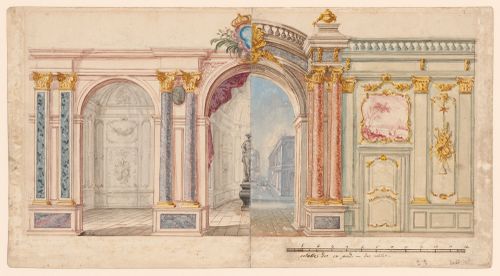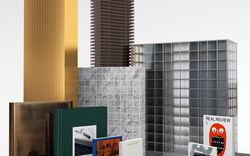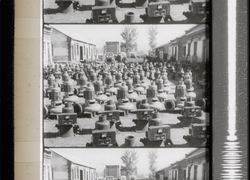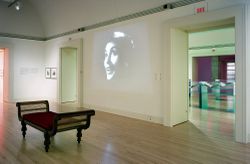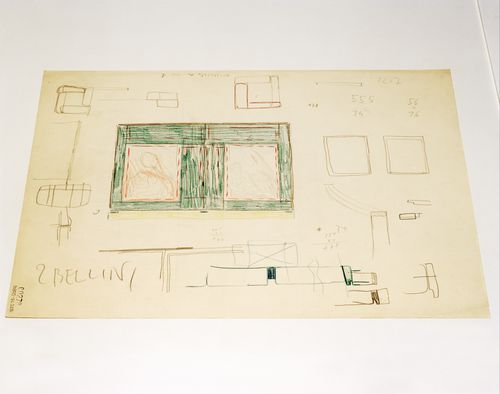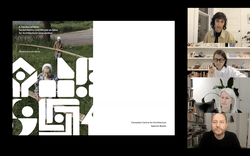DR1987:0400
Description:
- These sketches are mostly drawings for runway designs within the square site plan of the Los Angeles Municipal Airport project, with an elevation showing the massing of forms for the airport buildings. There are also at least three sketches for a segmentally-arched structure, possibly elevations for Lloyd Wright's second project for a shell for the Hollywood Bowl. This second project was commissioned in 1928; it was to be an elliptical shell, quarter-circular in elevation.
architecture
1929
Los Angeles Municipal Airport: Thumbnail site plans, conceptual elevations and perspectives with some elevations, possibly for the Hollywood Bowl shell
Actions:
DR1987:0400
Description:
- These sketches are mostly drawings for runway designs within the square site plan of the Los Angeles Municipal Airport project, with an elevation showing the massing of forms for the airport buildings. There are also at least three sketches for a segmentally-arched structure, possibly elevations for Lloyd Wright's second project for a shell for the Hollywood Bowl. This second project was commissioned in 1928; it was to be an elliptical shell, quarter-circular in elevation.
architecture
DR1967:0010:002
Description:
- The two halves of this drawing show alternate stage sets from which the patron could make his choice. It is unclear whether this design was for a painted trompe-l'oeil stage backdrop and/or a constructed stage set. The deep unified space and low vanishing point of the central piazza/hemicycle interior indicates that this section is probably a painted trompe-l'oeil, however, the curtain pulled back within the central arch and the inscribed scale suggest that some of the architectural elements may have been constructed (Fuhring, 161 and 570). An etching of the Hermes is laid down on the left variant of the central portion of the drawing. The prickings indicate that the overall design was intended to be executed, and the crown above the central cartouche indicates a possible royal connection.
theatre design
probably between 1745-1775
Presentation drawing for a stage set with alternate designs
Actions:
DR1967:0010:002
Description:
- The two halves of this drawing show alternate stage sets from which the patron could make his choice. It is unclear whether this design was for a painted trompe-l'oeil stage backdrop and/or a constructed stage set. The deep unified space and low vanishing point of the central piazza/hemicycle interior indicates that this section is probably a painted trompe-l'oeil, however, the curtain pulled back within the central arch and the inscribed scale suggest that some of the architectural elements may have been constructed (Fuhring, 161 and 570). An etching of the Hermes is laid down on the left variant of the central portion of the drawing. The prickings indicate that the overall design was intended to be executed, and the crown above the central cartouche indicates a possible royal connection.
theatre design
articles
With and Within
The First Ethical Housing Project, Kim Courrèges, Felipe de Ferrari, Plan Común, With and Within, Jack Self, REAL foundation
14 June 2021
An Ethical Real Estate Project
Kim Courrèges and Felipe de Ferrari of Plan Común speak with Jack Self of REAL about a society more equal in all dimensions
Actions:
With and Within
photographs
PH1986:0901:026:001
Description:
- This view looks west along the northern wall and moat of the Inner City of Peking (now Beijing). - On 11 October 1860, during the Second Opium War (1858-1860), the British and French forces positioned heavy siege guns along the southern wall (visible at c.l. to c.r. of PH1986:0901:026:002) of the Altar to Earth [Ditan] (also known as the Temple of Earth), threatening to bombard the walls of the Inner City of Peking (now Beijing) and demanding the surrender of the Anting Gate (now Anding Men) within forty-eight hours. The Chinese surrendered the gate at noon on 13 October 1860 (Harris, p. 145).
architecture, engineering, military
between 13 October and 24 October 1860
Partial view of the walls and moat of the Inner City, with the Anting Gate (now Anding Men) in the background, Peking (now Beijing), China
Actions:
PH1986:0901:026:001
Description:
- This view looks west along the northern wall and moat of the Inner City of Peking (now Beijing). - On 11 October 1860, during the Second Opium War (1858-1860), the British and French forces positioned heavy siege guns along the southern wall (visible at c.l. to c.r. of PH1986:0901:026:002) of the Altar to Earth [Ditan] (also known as the Temple of Earth), threatening to bombard the walls of the Inner City of Peking (now Beijing) and demanding the surrender of the Anting Gate (now Anding Men) within forty-eight hours. The Chinese surrendered the gate at noon on 13 October 1860 (Harris, p. 145).
photographs
between 13 October and 24 October 1860
architecture, engineering, military
This talk revisits the contested visual legacy of Michelangelo Antonioni’s 1972 documentary Chung Kuo, Cina by placing it within a broader network of Cold War–era encounters between Western filmmakers and a carefully stage-managed People’s Republic of China. Connecting Antonioni’s state-sanctioned visit with projects by Shirley MacLaine, Jean Painlevé, and Canadian(...)
Paul-Desmarais Theatre
22 January 2026, 6pm to 7:30pm
Screening of film excerpts and live annotation: Antonioni’s Chung Kuo, Cina (1972)
Actions:
Description:
This talk revisits the contested visual legacy of Michelangelo Antonioni’s 1972 documentary Chung Kuo, Cina by placing it within a broader network of Cold War–era encounters between Western filmmakers and a carefully stage-managed People’s Republic of China. Connecting Antonioni’s state-sanctioned visit with projects by Shirley MacLaine, Jean Painlevé, and Canadian(...)
Paul-Desmarais Theatre
Traces of India depicts the social, political, and anthropological role of images, showing how they laid the historical foundations—real and imagined—on which an ordered empire may have been constructed, rather than an assemblage of colonial trading relationships. Organized around six themes, the exhibition explores some of the greatest architectural sites of the Indian(...)
Main galleries
15 May 2003 to 14 September 2003
Traces of India: Photography, Architecture, and the Politics of Representation
Actions:
Description:
Traces of India depicts the social, political, and anthropological role of images, showing how they laid the historical foundations—real and imagined—on which an ordered empire may have been constructed, rather than an assemblage of colonial trading relationships. Organized around six themes, the exhibition explores some of the greatest architectural sites of the Indian(...)
Main galleries
PH2018:0005:028
Description:
Photograph by Stefano Graziani of the following work: Carlo Scarpa, Castelvecchio Museum, Ala della Reggia, elevation and sketches for the frame of the Madonna with the Child by Giovanni Bellini on the second floor of the Palace, inventory Number: 31805, recto, pastel red, yellow, blue two shades and lilac on cardboard, 316 x 432 mm, 1958-1961, Carlo Scarpa archive, Castevecchio Museum, Verona Questioning Pictures is a 36 photograph project commissioned by Fondazione Prada, Milan. Artist Stefano Graziani investigates archival and conservation systems in a number of museums. Through photographing museum objects, Graziani, focusing on the relationship between photographs, the museum objects and the power structures at play within institutions. The museums include the Canadian Centre for Architecture (CCA) in Montréal, Canada; Sir John Soane’s Museum in London, UK; the Kunstmuseum Basel, Switzerland; Museum Insel Hombroich in Neuss, Germany; the Museo di Castelvecchio in Verona, Italy; and the Plaster Cast Gallery at Museo Canova in Possagno, Italy.
2017
Questioning Pictures: Photograph of elevation and sketches for the frame of the Madonna with the Child by Giovanni Bellini on the second floor of the Castelvecchio Museum by Carlo Scarpa
Actions:
PH2018:0005:028
Description:
Photograph by Stefano Graziani of the following work: Carlo Scarpa, Castelvecchio Museum, Ala della Reggia, elevation and sketches for the frame of the Madonna with the Child by Giovanni Bellini on the second floor of the Palace, inventory Number: 31805, recto, pastel red, yellow, blue two shades and lilac on cardboard, 316 x 432 mm, 1958-1961, Carlo Scarpa archive, Castevecchio Museum, Verona Questioning Pictures is a 36 photograph project commissioned by Fondazione Prada, Milan. Artist Stefano Graziani investigates archival and conservation systems in a number of museums. Through photographing museum objects, Graziani, focusing on the relationship between photographs, the museum objects and the power structures at play within institutions. The museums include the Canadian Centre for Architecture (CCA) in Montréal, Canada; Sir John Soane’s Museum in London, UK; the Kunstmuseum Basel, Switzerland; Museum Insel Hombroich in Neuss, Germany; the Museo di Castelvecchio in Verona, Italy; and the Plaster Cast Gallery at Museo Canova in Possagno, Italy.
Conceived as part of the one-year investigation Catching Up with Life, A Section of Now aims to re-establish a dialogue between architecture and society that would allow for architecture to begin to contend with and address our changed and changing social norms. The publication serves as a meditation on new behaviours, rituals, and values and their spatial implications(...)
10 March 2022, 7:30pm to 8:30pm
A Section of Now, book launch with Giovanna Borasi
Actions:
Description:
Conceived as part of the one-year investigation Catching Up with Life, A Section of Now aims to re-establish a dialogue between architecture and society that would allow for architecture to begin to contend with and address our changed and changing social norms. The publication serves as a meditation on new behaviours, rituals, and values and their spatial implications(...)
photographs
PH1986:0901:026:001-002
Description:
- This view looks west along the northern wall and moat of the Inner City of Peking (now Beijing). - On 11 October 1860, during the Second Opium War (1858-1860), the British and French forces positioned heavy siege guns along the southern wall (visible at c.l. to c.r. of PH1986:0901:026:002) of the Altar to Earth [Ditan] (also known as the Temple of Earth), threatening to bombard the walls of the Inner City of Peking (now Beijing) and demanding the surrender of the Anting Gate (now Anding Men) within forty-eight hours. The Chinese surrendered the gate at noon on 13 October 1860 (Harris, p. 145).
architecture, engineering, military
between 13 October and 24 October 1860
Panorama showing part of the walls and moat of the Inner City, with the Anting Gate (now Anding Men) in the background, and part of the Altar to Earth [Ditan] (also known as the Temple of Earth), Peking (now Beijing), China
Actions:
PH1986:0901:026:001-002
Description:
- This view looks west along the northern wall and moat of the Inner City of Peking (now Beijing). - On 11 October 1860, during the Second Opium War (1858-1860), the British and French forces positioned heavy siege guns along the southern wall (visible at c.l. to c.r. of PH1986:0901:026:002) of the Altar to Earth [Ditan] (also known as the Temple of Earth), threatening to bombard the walls of the Inner City of Peking (now Beijing) and demanding the surrender of the Anting Gate (now Anding Men) within forty-eight hours. The Chinese surrendered the gate at noon on 13 October 1860 (Harris, p. 145).
photographs
between 13 October and 24 October 1860
architecture, engineering, military
Cause and Effect
In this talk, Michel Boulet, CCA photographer, and Louise Désy, Curator, Photographs, will discuss the photographic coverage of environmental catastrophes. A native of Lac-Mégantic, Michel Boulet was on location during the railway disaster on 6 July 2013, capturing images during the first hours following the accident. This conversation situates the work within larger(...)
Main galleries
10 December 2016, 3pm
Cause and Effect
Actions:
Description:
In this talk, Michel Boulet, CCA photographer, and Louise Désy, Curator, Photographs, will discuss the photographic coverage of environmental catastrophes. A native of Lac-Mégantic, Michel Boulet was on location during the railway disaster on 6 July 2013, capturing images during the first hours following the accident. This conversation situates the work within larger(...)
Main galleries

